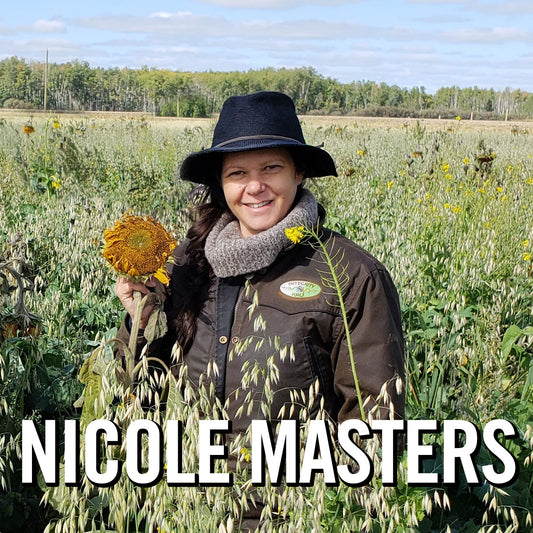An Excerpt from Nicole Masters book For the Love of Soil:
In hotter and drier environments, it’s the ants and termites who fill the niche of earthworms. They are nature’s garbage collectors, taking organic materials into their homes, aerating soil and improving water cycles. By increasing water infiltration and reducing erosion, these insects assist producers to increase resilience. Most people overlook these essential benefits, ignoring the insects’ feverish scramble as they tread upon their homes. Take a step back and you’ll see that plants around the nests grow densely with a more verdant green.
Termites may be key to staving off desertification, creating “hot spots” for biodiversity, moisture and nutrients.[i] As they build their complex tunnel systems, termites stabilise the sides with their mucus and faeces. This material is rich in organic matter and microbes, including the nitrogen fixers. Inside a termite’s belly, there exists one of the highest microbial concentrations in nature. These miniature ruminants contain bacteria and protozoa to help the termites break down what others can’t: wood, cellulose, lichen and dust. Unlike cows, who burp out their methane, termites fart more than any other organism on the planet, providing a rich food source for the methane loving (methanotrophic) bacteria.
The more species of ants and termites, the better, as they play different roles in an ecosystem. Studies comparing sites with and without, ants in wheat fields, showed a 36% increase in yield, where ants were present due to increases in nitrogen, microbial activity and water infiltration.[ii] Many species provide powerful pest control, eating other insects and their eggs.
When the Egyptians first constructed the pyramids at Giza, a group of termites in North-Eastern Brazil also started to build their edifice. These constructions are visible from space and calculations in 2018 show the area covered by their inter-connecting mounds is around the same size as Great Britain! The volume of soil excavated by these tiny insects could build 4,000 pyramids. To date, the queen of this awe-inspiring city has yet to be discovered.
Regenerators love to show off their earthworms and dung beetles like badges of honour. Ancient Egyptians revered the dung beetle as the God of creation and rebirth. This love of dung beetles is warranted; these macho soil bulldozers have a direct impact on the quantity and quality of grass, benefiting animal health, performance and beyond.
Digging holes to excavate around and under a cow pat can be hugely revealing as to the numbers and types of dung beetles at work. There are around 6,000 species of dung beetle, grouped by their actions as either tunnelers, dwellers or rollers. The first visual indicators that dung beetles have arrived are the pocked holes in manure; here you may find the dwellers working away with their young.
Globally, the most common type are the tunneling beetles, which show evidence of their work by a ring of mounds of different coloured subsoil around a pile of manure. These tunnelers dig down through the soil profile and carry their precious dung parcels 20 cm (8”) deep, to lay one egg into each ‘brood ball.’ Watching the sped-up footage of dung appearing to boil during a dung beetle feeding frenzy, can be quite transfixing.
Rollers, on the other hand, roll their tasty snacks away from the main pile, to bury with an egg or to eat later. These rollers can pull over a thousand times their body weight; an equivalent human effort would give you the strength to drag a blue whale. As a child, I remember watching David Attenborough gushing over two giant rollers with their heads down, tails up, fighting over elephant dung. Seeing these rollers, still fills me with nostalgia.
Dung beetle adults and the larvae differ in their feeding habits and their mouth parts. The mature adults have filtering mouths, more adapted to sucking up liquids and consuming microbes, while their larvae are the chewers, with mandibles that can grind up the tougher fibres in the dung mass. Adult dung beetles are good parents, often feeding their babies until they reach maturity and fly the nest. Many females only lay between 15 and 30 eggs in their lifetimes. This has an advantage in supporting the success of the next generation, but it also means dung beetle populations can take years to recover from disturbance events.
In every environment where there are animals making poop, there exists a poop-scooping companion, unless they were in New Zealand. When the first Polynesians arrived, there were no mammals, except for a few bats. Instead, the island environment supported a diverse range of birds that fitted into every niche, from small, mice-sized wrens, to herds of elk-like Moa (3m/10 feet tall), to a giant apex predator called the Pouakaia or Haasts Eagle. When Europeans first arrived, the Māori told tales of a giant bird that would dive from the skies and snatch away children. Of course, these stories were dismissed as fairytales, until 1871, when bones were discovered of an eagle measuring 3 m (12 feet) across. Potentially weighing in at 15 kg (33 lbs), the Pouakaia was up to 2 1/2 times heavier than a Bald Eagle, with claws as wide as a tiger. Its swooping dive attack has been compared to the impact of a concrete block thrown from an 8-story building.[iii] Their prey, the Moa, could weigh as much as 230 kg (510 lbs), requiring a mighty collision to knock them down. When their main food source was wiped out by the Māori in the 1400’s, this giant predator lived on only in bedtime horror stories.
It wasn’t until the late 18th century, that the ungulates (hooved animals) were first brought across the seas to New Zealand and no one considered inviting their poop-processing partners. The small native dung beetles adapted to bird guano, were literally overwhelmed by the 100 million tons of manure that loads the New Zealand environment every year. The country has one of the tightest border security systems in the world, learning the hard way, from the devastating incursions—both accidental and intentional—of rats, rabbits, possums, wallabies, stoats and spiders. As a result, it has been a protracted process, to reunite New Zealand ungulates with their dung beetle buddies. In 1956, a release of a single Mexican dung beetle species had some success. However, they didn’t stray far. The approval of 11 species in 2011, created nationwide excitement, with farmers spending thousands on ice-cream containers of beetles.
After boxes of beetles are purchased, their survival must be ensured. Finding literature about which chemicals are dung beetle safe, can be confusing. Some pesticides kill adults, some only kill juveniles, some reduce egg laying, while most create an environment that dung beetles will avoid. Just because a wormer is ‘organic,’ do not assume it will always be dung beetle friendly. Natural pyrethrums[iv] and garlic for example, may be linked to reductions in dung beetle diversity.
Some anthelmintics (dewormers) are eliminated in the urine, such as Albendazole and Levamisole, with reduced impacts on dung beetles. However, the wellbeing of the wider soil foodweb is potentially still at risk. The pour-ons and long-lasting bolus organophosphates and products such as Abamectin, which kills 100% of dung beetle larvae, are best avoided. Consider too that Ivermectin, when administered as a bolus, can keep killing dung beetles for four months following treatment.[v] Many chemical controls impact upon non-target species directly and indirectly, such as birds, bats and the super-beneficial predatory dung flies. As with many chemicals, there may be delayed reactions and non-lethal effects which are difficult to study. In New Zealand, the spread of dung beetles from their original release sites, is mainly concentrated on those farms avoiding the chemical controls.
Across the world, anthelmintic resistance is on the rise, due to the over-use and misuse of anti-parasitic drugs. According to Nick Sangster, a programme manager for Meat & Livestock Australia, “Nearly all standard anthelmintics have stopped working against sheep parasites.”[vi] New drugs, multiple combinations and increasing the frequency of deworming, are all short-term measures.
Jules Matthews, a key member of the Integrity Soils coaching team, uses several successful strategies to wean farms off the chemical drench treadmill. Jules has spent decades ranching and farming in America and New Zealand. She completed her Holistic Management training in 1980. She’s one of the most knowledgeable grass stewards I’ve come across. Her ability to increase lamb performance and carrying capacities on diverse, longer rotational pasture systems, is a skill many producers dream of. One strategy to reduce the need for anthelmintics Jules recommends, is to treat the younger and mature stock differently. There is little need to drench older animals. As livestock mature “they develop a natural level of resistance to parasites.” It’s important to monitor younger stock post-weaning. Without the immunity mother’s milk provides, they can be more susceptible to parasites until they develop their own resistance. At times animals can experience more stress, especially towards the end of pregnancy and early calving, which is when they can be more vulnerable to parasites. Support these animals by ensuring they have access to minerals and reduce stress as much as possible around weaning.
Typically, seeing production losses to parasites, points to nutritional problems, stress, or animals with low natural resistance. Some animals may have been bred to perform well in a high-input or feedlot systems. However, if livestock continue to struggle under a low-input system, they need to be removed from your breeding or finishing programmes.
Jules advocates regular monitoring and only drenching if required, to avoid any major stock health issues. Taking faecal egg counts is important. “If you are drenching on visual symptoms of an animal,” Jules says, “you have gone way past the point where you should have addressed the issue.” If anthelmintics must be used, a regenerative strategy is to leave a refuge for your dung beetles. This can be achieved by not drenching a minimum of 20% of the herd at any one time, so dung beetle populations can continue. During the withholding period, use a sacrifice area to contain animals while the drenches are most active. This will reduce the impacts across your entire landscape. These sacrifice areas can then be placed into a rehabilitation programme, to detoxify the longer-lasting effects on your microbial livestock.
[i] Pringle, R. M., Doak, D. F., Brody, A. K., Jocqué, R., & Palmer, T. M. (2010). Spatial pattern enhances ecosystem functioning in an African savanna. PLoS biology, 8(5),
[ii] Evans, T.A. et al. (2001) Ants and termites increase crop yield in a dry climate. Nat. Commun. 2:262 doi:0.1038/ncomms1257
[iii] Kennedy Warne. Hotspot: New Zealand, National Geographic Magazine, October 2002.
[iv] Bryony Sands et al. 2018. Sustained parasiticide use in cattle farming affects dung beetle functional assemblages , Agriculture, Ecosystems & Environment
[v] https://cen.acs.org/articles/95/i40/Drug-resistant-roundworms-prompt
[vi] Errouissi, F., Alvinerie, M., Galtier, P., Kerboeuf, D., & Lumaret, J. P. (2001). The negative effects of the residues of ivermectin in cattle dung using a sustained-release bolus on Aphodius constans (Duft.)(Coleoptera: phodiidae). Veterinary Research, 32(5)




